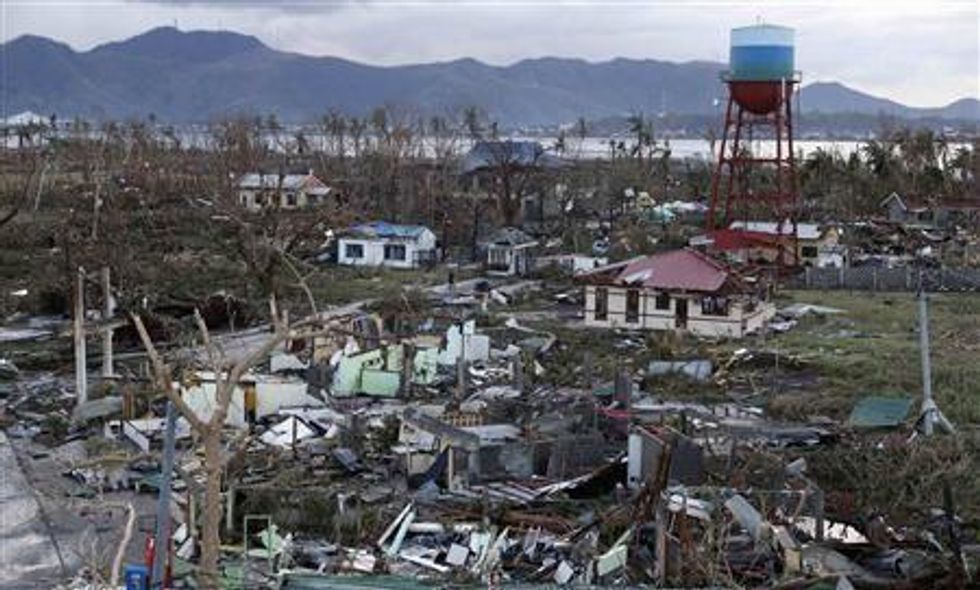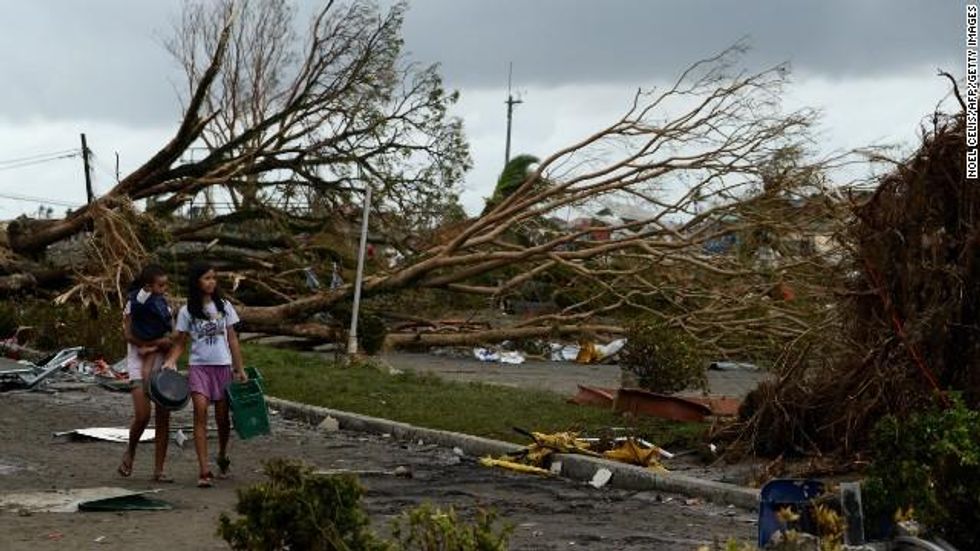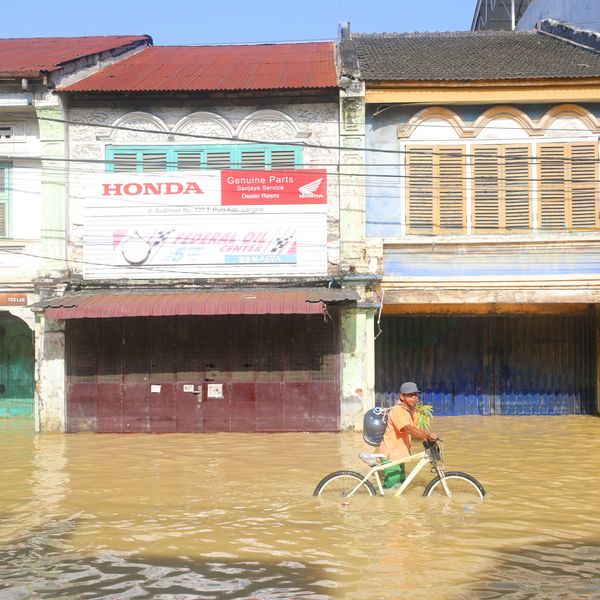At Least 10,000 Killed by Philippines Super-Typhoon
Rescue workeres struggle to reach survivors who are foraging for food and searching for loved ones

At least 10,000 people in the central Philippines are now reported dead after Typhoon Haiyan sent a tsunami-like surge of water and debris tearing through Leyte province, according to statements from a senior police official on Sunday.
The estimated death count, which increased nearly ten-fold from Saturday, could rise even higher as rescue workers struggle to reach highly damaged areas where survivors are searching the wreckage for loved ones and foraging for food.
"We have no food, we need water and other things to survive," Edward Gualberto told AFP at the outskirts of Tacloban--the coastal city hardest hit by the super-storm.
"People are walking like zombies looking for food," said Jenny Chu, a medical student in Leyte, in an interview with Reuters.
Earlier:
At least 1,200 lives have been lost, the Red Cross estimates, after super-typhoon Haiyan, likely the strongest storm to ever make landfall, slammed into the Philippines, leaving cities and towns in coastal areas devastated and bodies rotting in the streets.
"We estimate 1,000 people were killed in Tacloban and 200 in Samar province," said Gwendolyn Pang, secretary general of the Philippine Red Cross, of these island areas.
While the red cross expects to have a more precise count Sunday, they say it could take days to measure the true scale of this human tragedy, as communications are down in some of the hardest-hit areas.
Captain John Andrews, deputy director general of the Civil Aviation Authority of the Philippines, told the Associated Press that his staff reports more than 100 bodies lying in the streets of Tacloban, which was hardest hit by the typhoon.
Tacloban residents are searching the wreckage for food and water, CNN reports.
Six central Philippine islands were devastated when the typhoon hit Friday, with heavy flood water and fierce winds inflicting the most damage. "The sea engulfed Tacloban," said ABS-CBN television anchor Ted Failon, filing a report on Friday from Tacloban.
Simon Redfern, a professor of Earth sciences at Cambridge, explains that there is likely a link between climate change and increasing storm intensity: "As the planet and particularly the oceans heat, simple physics indicates that the energy stored is likely to increase the intensity and frequency of devastating storms like Haiyan, at great cost to coastal communities."
He adds, "While individual storms such as Haiyan cannot be directly attributed to such changes, the statistics of such storms will help build a picture of how climate change is affecting the planet."
The storm is moving quickly towards Vietnam, which it is expected to reach on Sunday.
The Philippines Red Cross Twitter feed has live updates.

_____________________
An Urgent Message From Our Co-Founder
Dear Common Dreams reader, The U.S. is on a fast track to authoritarianism like nothing I've ever seen. Meanwhile, corporate news outlets are utterly capitulating to Trump, twisting their coverage to avoid drawing his ire while lining up to stuff cash in his pockets. That's why I believe that Common Dreams is doing the best and most consequential reporting that we've ever done. Our small but mighty team is a progressive reporting powerhouse, covering the news every day that the corporate media never will. Our mission has always been simple: To inform. To inspire. And to ignite change for the common good. Now here's the key piece that I want all our readers to understand: None of this would be possible without your financial support. That's not just some fundraising cliche. It's the absolute and literal truth. We don't accept corporate advertising and never will. We don't have a paywall because we don't think people should be blocked from critical news based on their ability to pay. Everything we do is funded by the donations of readers like you. Will you donate now to help power the nonprofit, independent reporting of Common Dreams? Thank you for being a vital member of our community. Together, we can keep independent journalism alive when it’s needed most. - Craig Brown, Co-founder |

At least 10,000 people in the central Philippines are now reported dead after Typhoon Haiyan sent a tsunami-like surge of water and debris tearing through Leyte province, according to statements from a senior police official on Sunday.
The estimated death count, which increased nearly ten-fold from Saturday, could rise even higher as rescue workers struggle to reach highly damaged areas where survivors are searching the wreckage for loved ones and foraging for food.
"We have no food, we need water and other things to survive," Edward Gualberto told AFP at the outskirts of Tacloban--the coastal city hardest hit by the super-storm.
"People are walking like zombies looking for food," said Jenny Chu, a medical student in Leyte, in an interview with Reuters.
Earlier:
At least 1,200 lives have been lost, the Red Cross estimates, after super-typhoon Haiyan, likely the strongest storm to ever make landfall, slammed into the Philippines, leaving cities and towns in coastal areas devastated and bodies rotting in the streets.
"We estimate 1,000 people were killed in Tacloban and 200 in Samar province," said Gwendolyn Pang, secretary general of the Philippine Red Cross, of these island areas.
While the red cross expects to have a more precise count Sunday, they say it could take days to measure the true scale of this human tragedy, as communications are down in some of the hardest-hit areas.
Captain John Andrews, deputy director general of the Civil Aviation Authority of the Philippines, told the Associated Press that his staff reports more than 100 bodies lying in the streets of Tacloban, which was hardest hit by the typhoon.
Tacloban residents are searching the wreckage for food and water, CNN reports.
Six central Philippine islands were devastated when the typhoon hit Friday, with heavy flood water and fierce winds inflicting the most damage. "The sea engulfed Tacloban," said ABS-CBN television anchor Ted Failon, filing a report on Friday from Tacloban.
Simon Redfern, a professor of Earth sciences at Cambridge, explains that there is likely a link between climate change and increasing storm intensity: "As the planet and particularly the oceans heat, simple physics indicates that the energy stored is likely to increase the intensity and frequency of devastating storms like Haiyan, at great cost to coastal communities."
He adds, "While individual storms such as Haiyan cannot be directly attributed to such changes, the statistics of such storms will help build a picture of how climate change is affecting the planet."
The storm is moving quickly towards Vietnam, which it is expected to reach on Sunday.
The Philippines Red Cross Twitter feed has live updates.

_____________________

At least 10,000 people in the central Philippines are now reported dead after Typhoon Haiyan sent a tsunami-like surge of water and debris tearing through Leyte province, according to statements from a senior police official on Sunday.
The estimated death count, which increased nearly ten-fold from Saturday, could rise even higher as rescue workers struggle to reach highly damaged areas where survivors are searching the wreckage for loved ones and foraging for food.
"We have no food, we need water and other things to survive," Edward Gualberto told AFP at the outskirts of Tacloban--the coastal city hardest hit by the super-storm.
"People are walking like zombies looking for food," said Jenny Chu, a medical student in Leyte, in an interview with Reuters.
Earlier:
At least 1,200 lives have been lost, the Red Cross estimates, after super-typhoon Haiyan, likely the strongest storm to ever make landfall, slammed into the Philippines, leaving cities and towns in coastal areas devastated and bodies rotting in the streets.
"We estimate 1,000 people were killed in Tacloban and 200 in Samar province," said Gwendolyn Pang, secretary general of the Philippine Red Cross, of these island areas.
While the red cross expects to have a more precise count Sunday, they say it could take days to measure the true scale of this human tragedy, as communications are down in some of the hardest-hit areas.
Captain John Andrews, deputy director general of the Civil Aviation Authority of the Philippines, told the Associated Press that his staff reports more than 100 bodies lying in the streets of Tacloban, which was hardest hit by the typhoon.
Tacloban residents are searching the wreckage for food and water, CNN reports.
Six central Philippine islands were devastated when the typhoon hit Friday, with heavy flood water and fierce winds inflicting the most damage. "The sea engulfed Tacloban," said ABS-CBN television anchor Ted Failon, filing a report on Friday from Tacloban.
Simon Redfern, a professor of Earth sciences at Cambridge, explains that there is likely a link between climate change and increasing storm intensity: "As the planet and particularly the oceans heat, simple physics indicates that the energy stored is likely to increase the intensity and frequency of devastating storms like Haiyan, at great cost to coastal communities."
He adds, "While individual storms such as Haiyan cannot be directly attributed to such changes, the statistics of such storms will help build a picture of how climate change is affecting the planet."
The storm is moving quickly towards Vietnam, which it is expected to reach on Sunday.
The Philippines Red Cross Twitter feed has live updates.

_____________________

